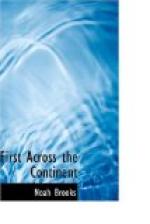Game was abundant all along the river as the explorers sailed up the stream. Their hunters killed numbers of deer, and at the mouth of Big Good Woman Creek, which empties into the Missouri near the present town of Franklin, Howard County, three bears were brought into the camp. Here, too, they began to find salt springs, or “salt licks,” to which many wild animals resorted for salt, of which they were very fond. Saline County, Missouri, perpetuates the name given to the region by Lewis and Clark. Traces of buffalo were also found here, and occasional wandering traders told them that the Indians had begun to hunt the buffalo now that the grass had become abundant enough to attract this big game from regions lying further south.
By the tenth of June the party had entered the country of the Ayauway nation. This was an easy way of spelling the word now familiar to us as “Iowa.” But before that spelling was reached, it was Ayaway, Ayahwa, Iawai, Iaway, and soon. The remnants of this once powerful tribe now number scarcely two hundred persons. In Lewis and Clark’s time, they were a large nation, with several hundred warriors, and were constantly at war with their neighbors. Game here grew still more abundant, and in addition to deer and bear the hunters brought in a raccoon. One of these hunters brought into camp a wild tale of a snake which, he said, “made a guttural noise like a turkey.” One of the French voyageurs confirmed this story; but the croaking snake was never found and identified.
On the twenty-fourth of June the explorers halted to prepare some of the meat which their hunters brought in. Numerous herds of deer were feeding on the abundant grass and young willows that grew along the river banks. The meat, cut in small strips, or ribbons, was dried quickly in the hot sun. This was called “jirked” meat. Later on the word was corrupted into “jerked,” and “jerked beef” is not unknown at the present day. The verb “jerk” is corrupted from the Chilian word, charqui, meaning sun-dried meat; but it is not easy to explain how the Chilian word got into the Northwest.
As the season advanced, the party found many delicious wild fruits, such as currants, plums, raspberries, wild apples, and vast quantities of mulberries. Wild turkeys were also found in large numbers, and the party had evidently entered a land of plenty. Wild geese were abundant, and numerous tracks of elk were seen. But we may as well say here that the so-called elk of the Northwest is not the elk of ancient




